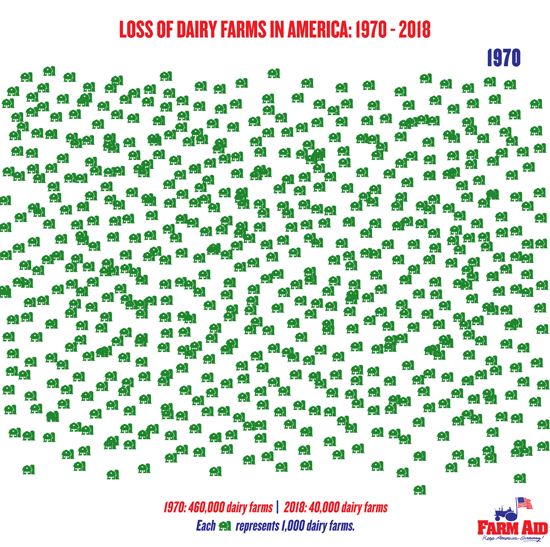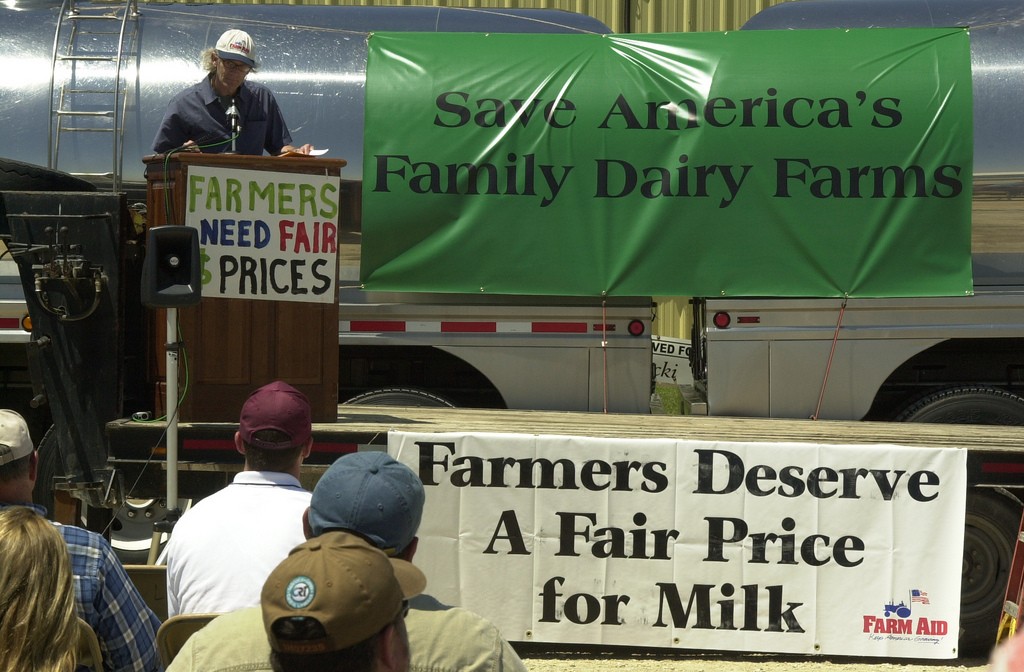Since 1970, the number of American dairy farms has dropped by more than 93 percent, from more than 640,000 to around 40,000 today.[1] In an industry dominated by corporate interests, family farms are constantly at risk of going under. A consistent, severe slump in milk prices in recent years has pushed many dairy farm businesses beyond the point of survival. In the last year, there’s been a 3 percent drop in the number of dairy farms, with the future of those remaining increasingly uncertain. Each day on our farmer hotline, we hear from dairy farmers whose farms are on the brink of foreclosure.
A Sour Pricing System
The dramatic loss of family dairy farms is the result of an unfair pricing system, which is heavily manipulated by major dairy corporations at the expense of farmers and eaters. For example, between 1998 and 2007, dairy farmers saw their share of the retail milk price drop by 25 percent, while retail prices increased by 40 percent. While farmers were paid less, and consumers paid more, corporate processors recorded windfall profits. Today, dairy farmers are paid far below their cost of production—leaving them with a financial loss each time they milk their cows. As of July 2018, dairy farmers received just $1.39 for a gallon of skim milk that retails for $4.49.[2]
This has been a trend, rather than the exception, over the last decade. In 2009, the milk market tanked, with prices plummeting and droves of family dairy farms closing their doors. While milk prices recovered somewhat in 2010 and 2011, it was not enough to help farmers recover from the previous year’s losses. Prices dipped again in 2012 just as persistent drought—the worst seen in the U.S. since the 1950s—and skyrocketing feed costs plagued dairy farmers. In the worst months of 2012, dairy farmers were losing up to $8.65 per hundredweight of milk they produced, translating to losses of tens or hundreds of thousands of dollars in a given month and draining rural economies. While milk prices peaked in 2014, today they have dropped to the lowest levels seen since 2009, hovering around $15 per hundredweight, far below the average cost of production of $22. Experts estimate a 19 percent drop in net cash farm income for dairy farmers in 2018.
Rise of Factory Farms and Growing Corporate Power
In recent years, the number of extremely large dairy farms has been on the rise, fueled by lax regulatory policies in several states and a flow of federal farm subsidies. The resulting overproduction of milk has slashed prices (now in their fourth consecutive year of falling below the cost of production) and flushed out small- and mid-sized dairies across the country.
Meanwhile, other players in the industry are taking over segments of the supply chain, vertically integrating in the same troublesome manner that we have see in the contract poultry industry. In March 2018, mega-retailer Wal-Mart unveiled the construction of its own dairy plant in Indiana, supplied by just 30 farms. This move is widely believed to have influenced Dean Foods’ decision to abruptly sever contracts with more than 100 dairy farms in eight states.[3]
How does the dairy crisis affect rural America?
As dairy farmers are forced into bankruptcy, a ripple effect on the local services that farmers use – such as banks, equipment dealers, seed and feed suppliers – further taxes rural economies. In regions like New England and the Upper Midwest, where multigenerational dairy farms have shaped the landscape and undergirded the regional economy, the shuttering of barn doors is sparking severe social and mental health crises and straining rural communities. For eaters, the loss of local dairies limits access to fresh, local milk products and often means a permanent loss of precious farmland to development. With fewer family farmers, the fate of our dairy products is left in the hands of factory farms and giant milk processors who have repeatedly cut corners with additives and processes that compromise the health and safety of milk.[4]
What can be done?
Until our milk pricing system pays farmers’ a fair price above their cost of production, dairy farmers remain at risk. So far in 2018, milk prices are 30 percent below the average cost of production. The U.S. Secretary of Agriculture has the authority to adjust milk prices when economic conditions severely affect farmers’ financial viability. In addition, Congress could make important changes to foster a fair marketplace for farmers, such as floor prices or supply management programs. Many dairy farmers are calling for this today, so we can finally and officially fix the milk pricing system.
In addition, eaters can seek out local dairy products at grocery stores, farmers’ markets and farm stands to support dairy farmers close to home. Buying as directly as possible from local farmers helps them capture as much of the food dollar as possible, and in turns boosts the local economy.
What is Farm Aid doing to address the crisis?
Through our hotline, Farm Aid provides counsel and distributes emergency funds to dairy farm families in crisis. Over the last decade, we’ve stood side-by-side with farmers and partner organizations to call attention to the dairy crisis, as dairy farmers have organized rallies nationwide. In addition, Farm Aid has helped fund trips for dairy farmers to Capitol Hill to highlight the impact of the loss of family dairy farms, while advocating for pricing reform and antitrust enforcement in the industry.
Farm Aid met with U.S. Secretary of Agriculture Tom Vilsack in 2009, delivering petitions signed by more than 13,000 farmers and eaters calling on the USDA to establish a fair floor price for milk. In 2010, when the USDA and Department of Justice launched a series of public workshops to examine antitrust conditions in agriculture, Farm Aid attended each one, including one specific to dairy, and helped support farmers to be there in person to be sure the voices of family farmers were heard loud and clear. In March 2018, Farm Aid advocated for a return to supply management in an op-ed published in The Hill, using the Canadian milk management system as an model. In April 2018, Farm Aid joined 53 organizations in calling on Congress and the Trump Administration to implement an emergency floor price for milk and institute a series of measures to respond to the dairy crisis.
Sources
1. USDA NASS. Milk Production (February 2018) https://release.nass.usda.gov/reports/mkpr0218.pdf.
2. National Farmers Union. The Farmer’s Share.
3. Walmart Opens Indiana Milk Plant. June 13, 2018. Farm Journal’s MILK Business.
4. Food & Water Watch. Milk Protein Concentrates; International Business Times (2013). “Aspartame in Milk: Big Dairy Wants to Sneak in Sweeteners Without Labels.”





